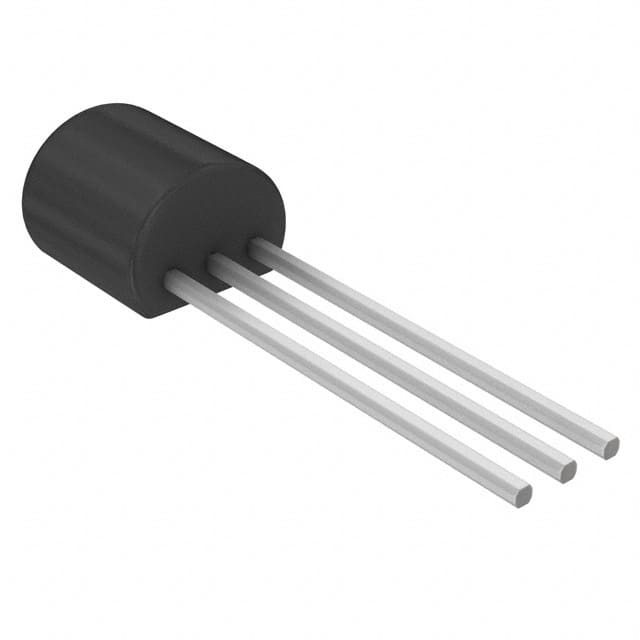Xem thông số kỹ thuật để biết chi tiết sản phẩm.

BC547BBU Transistor
Product Overview
The BC547BBU transistor is a versatile electronic component widely used in various applications. This entry provides comprehensive information about the BC547BBU, including its category, use, characteristics, packaging, specifications, pin configuration, functional features, advantages and disadvantages, working principles, application field plans, and alternative models.
Category
The BC547BBU transistor belongs to the category of bipolar junction transistors (BJTs). Specifically, it is classified as an NPN (negative-positive-negative) transistor.
Use
This transistor is commonly used for amplification and switching purposes in electronic circuits. It is suitable for low-power applications and can be found in audio amplifiers, signal processing circuits, and general-purpose electronic devices.
Characteristics
- Low power dissipation
- High current gain (hFE)
- Low noise
- Medium voltage capability
- Small package size
Package
The BC547BBU transistor is typically available in a TO-92 package, which is a small, plastic-encapsulated package with three leads for easy mounting on a printed circuit board (PCB).
Essence
The essence of the BC547BBU lies in its ability to provide reliable amplification and switching functions while consuming minimal power and offering low noise performance.
Packaging/Quantity
It is commonly supplied in reels or tubes containing multiple units, with quantities varying based on manufacturer and distributor specifications.
Specifications
- Collector-Base Voltage (VCBO): 50V
- Collector-Emitter Voltage (VCEO): 45V
- Emitter-Base Voltage (VEBO): 6V
- Collector Current (IC): 100mA
- Power Dissipation (PD): 500mW
- Transition Frequency (fT): 300MHz
Detailed Pin Configuration
The BC547BBU transistor has three pins: 1. Collector (C): This pin is connected to the positive supply voltage in typical circuit configurations. 2. Base (B): The input control signal is applied to this pin to control the transistor's operation. 3. Emitter (E): The output signal is obtained from this pin, and it is also connected to the ground reference in most applications.
Functional Features
- Amplification: The BC547BBU provides significant voltage and current amplification when used in appropriate circuit configurations.
- Switching: It can effectively switch between ON and OFF states, making it suitable for digital and analog signal processing.
Advantages
- Low power consumption
- High current gain
- Compact size
- Versatile applications
Disadvantages
- Limited voltage and current handling capabilities
- Susceptible to temperature variations
Working Principles
The BC547BBU operates based on the principles of controlling the flow of current between its collector and emitter terminals using a small input current at the base terminal. By modulating the base current, the transistor can amplify or switch the output signal.
Detailed Application Field Plans
The BC547BBU transistor finds extensive use in the following application fields: - Audio amplifiers - Signal processing circuits - Sensor interfaces - Oscillator circuits - Voltage regulators
Detailed and Complete Alternative Models
Several alternative models with similar characteristics and pin configurations are available in the market, including: - 2N2222 - BC548 - 2N3904 - BC337
In conclusion, the BC547BBU transistor is a fundamental component in electronic circuit design, offering reliable amplification and switching capabilities for a wide range of applications.
Word Count: 533
Liệt kê 10 câu hỏi và câu trả lời thường gặp liên quan đến ứng dụng BC547BBU trong giải pháp kỹ thuật
What is the BC547BBU transistor used for?
- The BC547BBU is a general-purpose NPN bipolar junction transistor commonly used for amplification and switching applications in electronic circuits.
What are the typical operating conditions for the BC547BBU?
- The BC547BBU operates within a voltage range of 45V and a current rating of 100mA, making it suitable for low-power applications.
Can the BC547BBU be used for audio amplification?
- Yes, the BC547BBU can be used for small-signal audio amplification due to its low noise and high gain characteristics.
What are the pin configurations of the BC547BBU?
- The BC547BBU has three pins: the emitter (E), base (B), and collector (C), which are arranged in a specific configuration on the transistor package.
Is the BC547BBU suitable for switching applications?
- Yes, the BC547BBU can be used for low-power switching applications due to its fast switching speed and moderate current handling capability.
What are the typical circuit configurations for using the BC547BBU as an amplifier?
- The BC547BBU can be configured in common-emitter or common-collector configurations for amplification purposes.
Are there any specific thermal considerations when using the BC547BBU?
- It is important to consider the thermal dissipation of the BC547BBU, especially when operating at higher currents, to prevent overheating and ensure reliable performance.
Can the BC547BBU be used in digital logic circuits?
- While the BC547BBU is primarily used in analog circuits, it can be utilized in certain digital logic applications, particularly at lower frequencies.
What are the typical alternatives to the BC547BBU?
- Common alternatives to the BC547BBU include the 2N2222, 2N3904, and PN2222 transistors, which offer similar characteristics and can be used interchangeably in many applications.
Where can I find detailed datasheets and application notes for the BC547BBU?
- Detailed datasheets and application notes for the BC547BBU can be found on semiconductor manufacturer websites, electronics component distributors, and technical documentation repositories.

